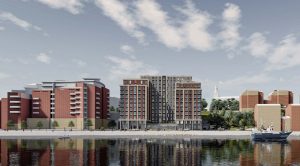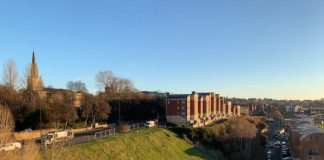Residents opposed to controversial plans for a “monolithic” apartment block on Newcastle’s Quayside face an anxious wait for answers after the second planning inquiry came to an end.
Lawyers representing the city council; developers Packaged Living and Robertson Property; and residents of St Ann’s Quay made their closing statements in the inquiry on Monday after several days of deliberation across two weeks in November. However, the planning inspector has said a decision is unlikely to come before Christmas.
The long-running dispute saw the plans initially blocked by Newcastle City Council in 2021 – but that decision was then quashed on appeal in the first planning inquiry a year later. That wasn’t the end of the drama however, as that decision was in turn quashed by the High Court and the judgement held up in the court of appeal, leading to the second inquiry.
The 14-storey block would contain 289 apartments as part of a build-to-rent scheme. The developer has claimed it would be a “high quality” addition to the Quayside, while opponents fear it would have a detrimental impact on heritage assets including the Grade I listed St Ann’s Church.

Residents of the neighbouring St Ann’s Quay apartment block also claimed that the new development would “decimate” their living conditions. Speaking at Monday’s session of the inquiry, lawyer David Hardy gave his closing statements on behalf of the residents.
He said: “It remains a monolithic block of flats with a design influenced by cost. Existing residents of St Ann’s Quay deserve better; future residents deserve better; the Quayside itself deserves better.
“There are simply too many factors against the scheme for it to be considered acceptable. The fact that people may be willing to live in substandard accommodation doesn’t mean the planning system should allow it.”
Mr Hardy also drew attention to the fact some of the apartments fell below the Government’s nationally described space standard (NDSS), outlined in 2015. Mr Hardy said the proposed development would have apartments covering 18.8 square metres, whereas St Ann’s Quay apartments were 39.5 square metres.
It meant the plot 12 sites would have “more than twice the number of apartments” in a “comparable area”.
Meanwhile, the city council’s representative, Anjoli Foster, defended the council as a “positive” local authority that rarely refused planning applications for residential developments. She added that the objections to the development demonstrated “how inappropriate” the proposals are.
Ms Foster continued: “There is no desperate urgency to get something built on plot 12, and no need that means a flawed scheme should be built. A scheme on this site needs to be the right development and of sufficient quality.
“The council are the custodians of the Quayside and St Ann’s Chuch which are vital to the distinctness of Newcastle. It is the jewel in the crown of Newcastle and the appellant has failed to recognise and respect that.”
Ms Foster also argued that the city had enough housing in the pipeline to meet the need – however, this was disputed by Paul Tucker on behalf of the appellant. He claimed the assessment was “out of date” due to new Government guidance that had seen city’s housing targets increase by up to 35%.
He also accused the scheme’s opponents of asking for a “different conclusion” to the previous inquiry “on the basis of similar evidence”.
Mr Tucker continued: “This is a site that has been crying out for development since Margaret Thatcher was Prime Minister. This development is the right development, in the right place at the right time.
“The idea that a similar development is in the wings is evidenced by speculation. The harm done is outweighed by the benefits.
“The site has lain undeveloped for decades. It is risible to suggest that this site is anything other than complex, there is no better scheme waiting in the wings and there is no perfect scheme that will please everybody.
“We say the balance is overwhelmingly in favour of a sustainable scheme, and it should be the outcome of an appeal – again.”




